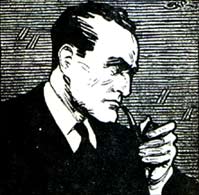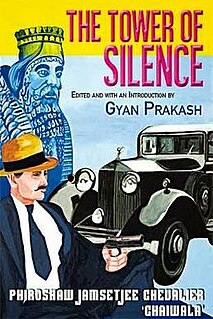Related Research Articles

Sexton Blake is a fictional character, a detective who has been featured in many British comic strips, novels and dramatic productions since 1893. Sexton Blake adventures were featured in a wide variety of British and international publications from 1893 to 1978, comprising more than 4,000 stories by some 200 different authors. Blake was also the hero of numerous silent and sound films, radio serials, and a 1960s ITV television series.

True As Steel is a 1924 American silent drama film directed and written by Rupert Hughes.

Meet Sexton Blake! is a 1945 British supporting feature drama film directed by John Harlow and starring David Farrar, Manning Whiley, Dennis Arundell, and John Varley. It was one of two films in which David Farrar played Sexton Blake, the other being The Echo Murders (1945), both directed by John Harlow. Important documents are stolen from a dead man during an air raid, and the War Office call in Sexton Blake to investigate.
Sexton Blake and the Hooded Terror is a 1938 British crime film directed by George King and starring George Curzon, Tod Slaughter and Greta Gynt. It was George Curzon's third and final outing as the fictional detective Sexton Blake.
The Squire of Long Hadley is a 1925 British silent drama film directed by Sinclair Hill and starring Marjorie Hume, Brian Aherne and G. H. Mulcaster It was adapted from a novel by E. Newton Bungay and was also known under the alternative title of Romance of Riches.
The Duchess of Seven Dials is a 1920 British silent romance film directed by Fred Paul and starring Cecil Mannering, Marjorie Hume and Adelaide Grace. Its plot involves a young aristocratic woman who falls in love with a curate doing charitable work in the Seven Dials area of Central London. It was made by the London Film Company.
Mark Hodder is an English author, since 2008 living in Spain. His six-part series of 'Burton & Swinburne' steampunk novels opened with The Strange Affair of Spring-Heeled Jack, which went on to win the 2010 Philip K. Dick Award. The following two novels, The Curious Case of the Clockwork-Man and Expedition to the Mountains of the Moon, were released in 2011 and 2012 respectively to wide acclaim from fans of the genre, with the latter nominated for a Sidewise Award. His fourth novel in the Burton & Swinburne series, The Secret of Abdu El Yezdi, was also nominated for a Sidewise Award.
Second to None is a 1927 British silent war film directed by Jack Raymond and starring Moore Marriott, Ian Fleming and Benita Hume. The screenplay concerns a naval family who come under strain when their son goes absent without leave to settle a domestic problem with his wife.
The Burgomaster of Stilemonde is a 1929 British silent drama film directed by George Banfield and starring John Martin Harvey, Fern Andra and Robert Andrews. It was made at Walthamstow Studios and on location in Belgium. It was based on the 1918 play Le Bourgmestre de Stilmonde by Maurice Maeterlinck. Like the play, it portrays German atrocities during the First World War occupation of Belgium. It was well received by critics.

Behold My Wife! is a lost 1920 American silent drama film directed by George Melford and starring Mabel Julienne Scott and Milton Sills in a filmization of Sir Gilbert Parker's novel, The Translation of a Savage. Famous Players-Lasky produced the film and Paramount Pictures distributed.

The Tower of Silence is a novel by Indian author Phiroshaw Jamsetjee Chevalier, allegedly written in 1927 and recovered from a lost manuscript by historian Gyan Prakash. It was first published in complete form by HarperCollins in 2013.

The Marcellini Millions is a 1917 American drama silent film directed by Donald Crisp and written by George Beban and Edith M. Kennedy. The film stars George Beban, Helen Jerome Eddy, Pietro Sosso, Henry Woodward, Fred Huntley and Mae Gaston. The film was released on May 14, 1917, by Paramount Pictures.
Expiation is a 1922 British silent crime film directed by Sinclair Hill and starring Ivy Close, Fred Raynham and Lionelle Howard. It was based on an 1887 novel by E. Phillips Oppenheim. The film was made by Stoll Pictures at the Cricklewood Studios.
A Daughter of Love is a 1925 British silent drama film directed by Walter West and starring Violet Hopson, John Stuart and Jameson Thomas.

The Barefoot Boy is a 1923 American silent drama film directed by David Kirkland and starring John Bowers, Marjorie Daw, and Sylvia Breamer. The film is based upon a poem of the same name by John Greenleaf Whittier.
Sexton Blake and the Demon God is a 1978 six-part British BBC miniseries starring Jeremy Clyde as the fictional detective Sexton Blake. It was scripted by Simon Raven, directed by Roger Tucker and produced by Barry Letts. The serial was broadcast by BBC One at tea-time from Sunday, 10 September 1978, until Sunday, 15 October 1978. Like the 1967–1971 Sexton Blake series, it is set in the 1920s.
Francis (Frank) Howel Evans (1867–1931) was a Welsh author who wrote for many British story papers such as Chums, The Boy's Own Paper, and The Boys' Friend during the first few decades of the 20th century. He also wrote under the pen names Atherley Daunt and Crutchley Payne. Many of his stories take place in the theatre.

George Hamilton Teed was a Canadian author who also wrote under the pen-names G. H. Teed, Peter Kingsland, and Desmond Reid. Teed was born in Woodstock, New Brunswick. He specialized in adventure fiction and detective stories starring Sexton Blake, but also wrote a few science fiction tales and several stories starring detectives Nelson Lee and Dixon Hawke. He penned over 400 tales and is considered to be one of the best Sexton Blake authors of all time. He created the longest list and the most varied gallery of characters in the Blake canon, his most unique contribution perhaps being the many strong female adversaries he pitted against Blake.

Robert Murray Graydon was a British novelist who also wrote under the pen-names Robert Murray, Murray Hamilton, and Murray Roberts. He is best remembered for his Sexton Blake stories featuring the Criminals' Confederation, a global criminal organisation that featured prominently in the Blake magazines from 1916 to the 1930s.

William Murray Graydon was an extremely prolific American writer who also wrote under the pen-names Alfred Armitage, William Murray, and Tom Olliver. He wrote adventure, historical fiction and Sexton Blake detective stories for boy's story papers.
References
- 1 2 3 4 5 6 7 Hodder, Mark. "Sexton Blake Filmography". Blakiana. Retrieved 10 July 2020.
- ↑ "Search results for Sexton Blake". Huntley Film Archives. Retrieved 10 July 2020.
- ↑ Hodder, Mark. "Sexton Blake Bibliography: 1927". Blakiana. Retrieved 14 July 2020.
- ↑ Hodder, Mark. "Sexton Blake Bibliography: 1917". Blakiana. Retrieved 14 July 2020.
- ↑ Hodder, Mark. "Sexton Blake Bibliography: 1926". Blakiana. Retrieved 14 July 2020.
- ↑ Wright, Norman (1989). "Introduction". The Sexton Blake Detective Library. Fleetway Publications. p. 11. ISBN 0-948248-96-3 . Retrieved 10 July 2020.